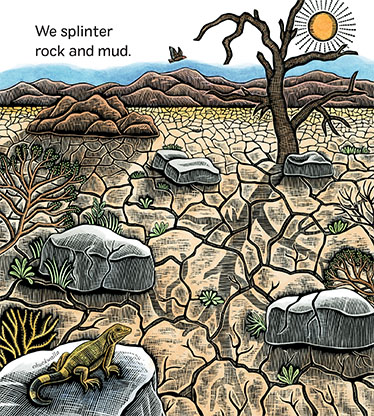Reviews for We Are Branches
Starred Review: Booklist, May 1, 2023
In this follow-up to Swirl by Swirl (2011), author Sidman and Caldecott-winning illustrator
Krommes team up again to introduce another beautiful—and useful—pattern in nature:
branches. Beginning with tree limbs, the most obvious form of branches, poetic text and
luminous scratchboard illustrations with refined watercolors explain the purpose of different
branches from the branches’ points of view. The tree imagery continues with roots and
transitions to flower petals. Recognizing that branches are not solely plant properties, however, water takes prominence, progressing from streams to rivers that form branches to the ocean. Still more branches carve through nature, accompanied here by strong verbs, from lightning “splitting the sky with energy” to cracks that “splinter rock and mud” to snowflake crystals that “sprout in ice.” A short lull in the text (“From small to big, / we repeat again and again”) combines with double-page illustrations to emphasize fractals and the breadth of branches before transitioning yet again to a range of animals (including humans) and their branched antlers, legs, toes, arms, wings, and even circulatory systems. Labeled plants and animals and a variety of perspectives, such as Canada geese’s aerial view of branching rivers, add pleasing elements, while concluding notes offer further information on how branches contribute to nature. This STEM concept book turns to STEAM through exquisite detail and design.— Angela Leeper
Publishers Weekly, March, 2023
Living things—and not just trees—often grow in branching forms, as detailed in this intricate picture book. Via instantly recognizable scratchboard spreads, Krommes draws branching life with exquisite delicacy, ranging across landscapes and locales. “Look/ how we grow:/ lifting toward the sun,” Sidman writes in expansive lines as illustrations look upward into the branches of a forest. Tree roots take this form, too (“We sink... to drink/ and grasp and steady”)—as do rivers, lightning bolts, ice crystals, coral, animalian limbs, and more (about the wing bones of short-nosed fruit bats, “arms that stretch wide/ into fabulous fingers”). In graceful, generous profusion, various labeled organic forms are shown dividing and redividing into smaller sections while children of varying skin tones play in the background. Further information about patterns in nature concludes this striking study of growing forms’ startling similarity: “Branching is the shape of life!” Ages 4–8.
Kirkus Reviews, March 1, 2023
The creators of Swirl by Swirl: Spirals in Nature (2011) salute another of the world’s essential and ubiquitous patterns.
“Branching is nature’s most efficient way to spread something…from one central spot over a large area,” Sidman writes at the end—going on in prose to unpack examples her preceding free verse just touches on and to introduce the concept of fractals. By that point she has taken readers through the natural world, beginning with tree branches, “lifting toward the sun, / spreading wide / to catch each / drop of light,” and proceeding to roots, the wings of birds and butterflies, lightning, coral, snowflakes, and, finally, closer to home, arms, legs, and blood vessels: “Then we pour back in rivers / toward your heart.” Flowing with similar strength and lyricism, Krommes’ color scratchboard scenes offer minutely examined bat wings and flowers along with glimpses of a trio of playful tan-skinned children in support of the poet’s rapturous conclusion that branching is “the shape of life!” They also reflect a broader truth with scenes of forked rivers and lightning, fronds of frost, a flat expanse of cracked mud, and deeply furrowed mountain slopes. (This book was reviewed digitally.)
Explores a fundamental concept with characteristic grace and simplicity. (Informational picture book. 6-8)
The Bulletin, April, 2023
Sidman follows up her poetic exploration of spirals in nature (Swirl by Swirl, BCCB 11/11) with a similar look at the persistence of branches and branching, which she defines as a “pattern that divides into two, forming a Y.” The book starts with the most obvious example in tree branches as they are “lifting toward the sun, spreading wide to catch each drop of light.” From there, viewers get a look at the tree’s roots, also a relatively easy place to spot branching, but the book asks for a bit more observation as it moves along: what about the thin veins visible in a flower petal; the layering of a bird’s feathers; the crackling bursts of lightning; the angular points of a snowflake? A river spreads into branches, as do the bones making up a bat’s wings. And speaking of bones, the entire human body is made up of branching tissue, veins, and bones. With spare but imagistic text, Sidman highlights the interconnectedness of life, clearly conveying how branching is an essential part of nature as it is the “most efficient way to spread something (like water or energy) from one central spot over a large area.” Krommes’ defined, crisp scratchboard art is especially effective in following various lines as they branch out and out again, ensuring that borders and throughlines take center stage against softer hues. This would pair nicely with Swirl by Swirl or Chin’s recent The Universe in You: A Microscopic Journey (BCCB 10/22) for a look at commonalities and connection in the natural world. KQG

